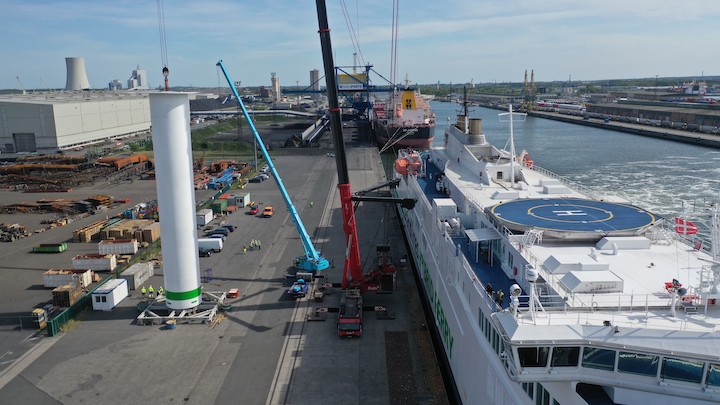Since 2013, Scandlines has invested more than EUR 300 million in building and converting conventional ferries into hybrid ferries. In 2020, the ferry operator added environmentally friendly wind propulsion technology to the list of green initiatives by installing a Norsepower Rotor Sail on the hybrid ferry Copenhagen, which operates on the Rostock-Gedser route between Germany and Denmark. With the Rotor Sail from Finnish Norsepower, Scandlines has reduced CO2 emissions from the hybrid ferry by an average of 4% and, on good days with optimal wind conditions, by as much as 20%.
The Rotor Sail – a 30m high rotating cylinder - is a modern version of the Flettner rotor and the technology is based on the Magnus effect. When wind meets the spinning Rotor Sail, the airflow accelerates on one side of the Rotor Sail and decelerates on the opposite side. The change in the speed of airflow results in a pressure difference, which creates a lift force that is perpendicular to the wind flow direction.
This lift force allows Scandlines to reduce the use of diesel engines and therefore reduces both the fuel consumption and associated emissions.

The technology has the optimum effect when there is a wind blowing 20 m/s a little abaft abeam and the wind is perpendicular to the sail. The route between Gedser to the north and Rostock to the south is almost perpendicular to the prevailing wind from the west (or a little less frequently east) giving Scandlines favourable conditions for using Rotor Sails on the crossing.
Michael Guldmann Petersen, COO, Scandlines said: “After positive experiences with the Rotor Sail on the Scandlines hybrid ferry Copenhagen, Scandlines had prepared the sister ferry Berlin for a Rotor Sail as well. We are happy to see, that the installation was successfully completed and that the ferry went into operation again this morning as planned.”
On 16 May 2022, Scandlines installed the Norsepower Rotor Sail on M/V Berlin in the port of Rostock while the ferry was out of service for a few hours.
Tuomas Riski, CEO, Norsepower commented on the latest installation: “Scandlines is taking the international GHG emissions reductions targets extremely seriously and is demonstrating a leading approach to investing in innovation to supersede these. Expanding its use of our Rotor Sail technology on its second vessel highlights the viability of wind power, and the significance of the emissions savings which can be achieved.”
The Norsepower Rotor Sail solution is fully automated. The system measures the wind speed and direction and based on these measurements calculates whether use of the Rotor Sail will reduce emissions. If so, the Rotor Sail starts automatically. However, for specific port areas which are not suitable for Rotor Sail use, the Rotor Sail solution has settings to ensure the technology will not be activated.

Follow us on social media: